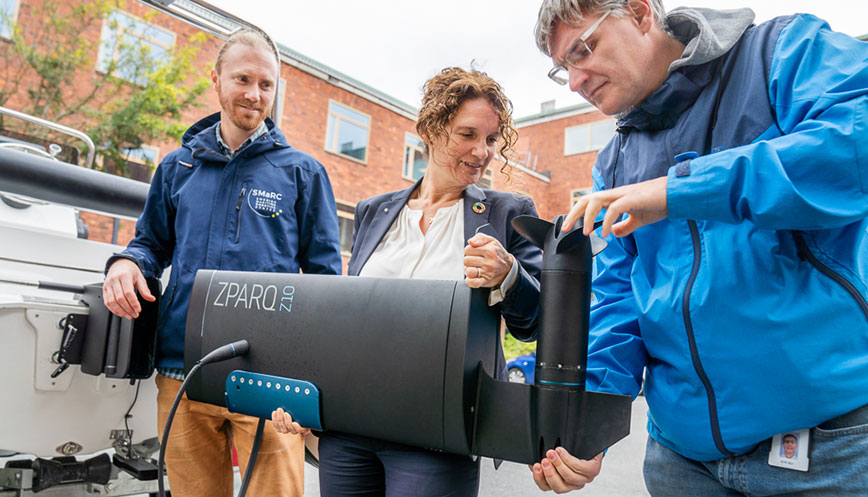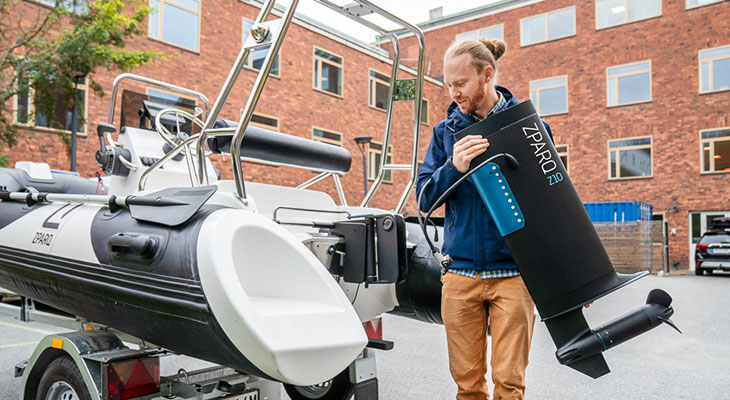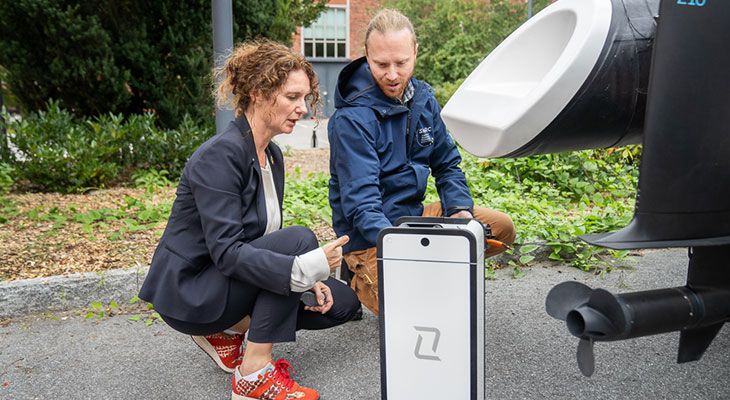Electrically-powered boat motor showcased for KTH Energy Platform

KTH spin-out Zparq is set to launch its first electric motor for leisure boats next year. The technology, which is being refined in collaboration with KTH’s Division of Electric Power and Energy Systems (EPE) and others, was shown at KTH Energy Platformen’s study visit at the School of Electrical Engineering and Computer Science (EECS).
Stockholm has become something of a cluster for the development of next generation electric vessels. Innovators include KTH spin-out Zparq, which is developing a new form of electric propeller motor: a so-called pod motor that is positioned below the waterline. The goal is to contribute to the electrification of shipping with a sustainable solution suited for today’s leisure boats.
Nicholas Honeth is a researcher at the EPE and one of the founders of Zparq. One sunny autumn day in September, he put Zparq’s test rig on a boat trailer to demonstrate the technology to KTH Energy Platform’s steering group.
“It’s incredibly interesting to hear about a technology that could play a key role in the electrification of shipping. The fact that it was developed at KTH makes us particularly proud,” says Lina Bertling Tjernberg, Director KTH Energy Platform.
The development of the technology originated in the FoilCart research project from 2016, which is part of the KTH Baltic Tech Initiative and is financed by the Swedish Transport Administration. The aim has been to develop a more compact system for airfoil technology on boats. As part of this effort, researchers have developed an entirely new electric motor and driveline for propeller operation, which is now coming to fruition in Zparq.
The company has been developed with support from KTH Innovation and the EIT Innoenergy Highway Program.
“It’s been such an exciting journey from the research stage to establishing a business, and one in which we’ve had invaluable support from KTH Innovation. Getting to go all the way to becoming a company that can stand on its own two feet is a fantastic experience,” Honeth says.
More research collaborations
Zparq has set its sights on electric motors in the 10-50 kW range and the company’s first product is an outboard motor set for launch in 2024.
“Performance is strongly dependent on the size of the propeller and to find the best combination of a range of factors, including propeller size and speed, we collaborate with the RISE research institute and KTH’s Division of Electrical Power and Energy Systems.”
Zparq participates in several research projects in which KTH also partners. These include ELINN – Electric Innovation , which aims to develop a full-size search and rescue vessel with hovercraft technology for the Swedish Sea Rescue Society, and Next Generation Hydrofoil Systems for Robust and Effective Electric Work Boats (NG-FREEBS) .
Zparq’s submersible pod motor resembles a cigar-shaped cylinder with a hole through the centre. The hole allows water in to cool the motor. Magnets in the electric motor are positioned to maximize power and its ceramic bearings are water-resistant.
“We’ve run the technology for more than 1,000 hours to test everything from potential corrosion to the growth of algae and barnacles,” Honeth says.

All parts of the system are light enough to be handled by one person. With an experienced grip, Honeth lifts the approximately 15 kilo pod motor from its stand.
“From the outset, we’ve focused on developing a solution in which it should be easy to lift off the motor even if you’re alone. Design work has also been very important – the entire powertrain must look modern and stylish,” says Honeth.
In-house battery solution
Although its electric motor is the company’s most important innovation, it has also developed its own portable battery solution. The prototype vessel on the trailer can reach speeds of up to 17 knots, although at such speeds the 3 kilowatt battery only provides power for about 30 minutes of operation. With more batteries on board or a lower speed, operating times are significantly longer.
Safety has been a particular focus. The powertrain needs to be able to cope with electric motors that immediately produce full power. In addition, the solution needs to alert those in its surroundings that it is operating, as it is virtually silent.

The company hopes to bring its pod motor to market within a year. In the long-term, it hopes to conduct all manufacturing in Europe. There are already several electric boat motor manufacturers, such as Torqeedo, OceanVolt, ePropulsion, and Pure Watercraft. But Zparq’s technology is more cost-effective and has a significantly lower climate footprint across the entire value chain, thanks to its compact design, explains Honeth.
“The outboard solution is also just one way of using the technology. The pod motor can also be used on a hydrofoil and then it comes into its own even more,” he says.
In addition to leisure boats, the company is looking more closely at solutions for smaller work vessels, such as taxi boats. These can be constructed with fixed battery solutions and charged at planned charging points.
Read more about how climate-smart electric shipping can be included in a degree project at KTH
Text: Magnus Trogen Pahlén

